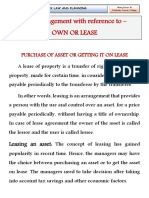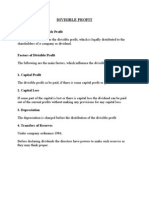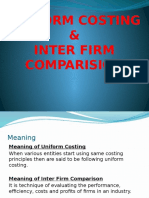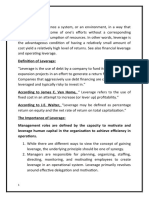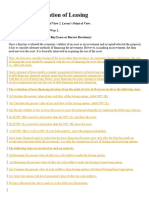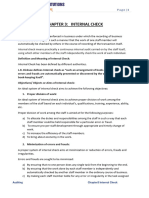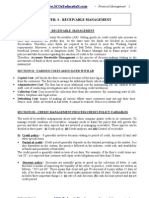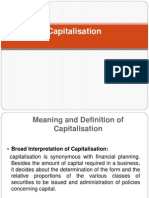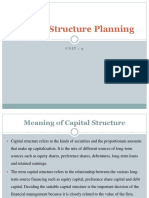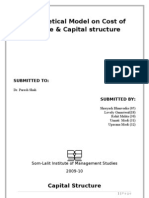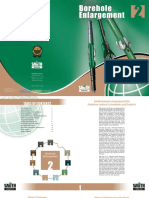Capital Structure
Capital Structure
Uploaded by
Adeem AshrafiCopyright:
Available Formats
Capital Structure
Capital Structure
Uploaded by
Adeem AshrafiOriginal Description:
Copyright
Available Formats
Share this document
Did you find this document useful?
Is this content inappropriate?
Copyright:
Available Formats
Capital Structure
Capital Structure
Uploaded by
Adeem AshrafiCopyright:
Available Formats
CAPITAL STRUCTURE
MEANING OF CAPITAL STRUCTURE Capital structure refers to the kinds of securities and the proportionate amounts that make up capitalization. It is the mix of different sources of long-term sources such as equity shares, preference shares, debentures, long-term loans and retained earnings. The term capital structure refers to the relationship between the various long-term source financing such as equity capital, preference share capital and debt capital. Deciding the suitable capital structure is the important decision of the financial management because it is closely related to the value of the firm. Capital structure is the permanent financing of the company represented primarily by long-term debt and equity. DEFINITION OF CAPITAL STRUCTURE The following definitions clearly initiate, the meaning and objective of the capital structures. According to the definition of Gerestenbeg, Capital Structure of a company refers to the composition or make up of its capitalization and it includes all long -term capital resources. According to the definition of James C. Van Horne, The mix of a firms permanent long-term financing represented by debt, preferred stock, and common stock equity. According to the definition of Presana Chandra, The composition of a firms financing consists of equity, preference, and debt. According to the definition of R.H. Wessel, The long term sources of fund employed in a business enterprise. FINANCIAL STRUCTURE The term financial structure is different from the capital structure. Financial structure shows the pattern total financing. It measures the extent to which total funds are available to finance the total assets of the business. Financial Structure = Total liabilities Or Financial Structure = Capital Structure + Current liabilities. The following points indicate the difference between the financial structure and capital structure.
OPTIMUM CAPITAL STRUCTURE Optimum capital structure is the capital structure at which the weighted average cost of capital is minimum and thereby the value of the firm is maximum. Optimum capital structure may be defined as the capital structure or combination of debt and equity, that leads to the maximum value of the firm. Objectives of Capital Structure Decision of capital structure aims at the following two important objectives: 1. Maximize the value of the firm. 2. Minimize the overall cost of capital. Forms of Capital Structure Capital structure pattern varies from company to company and the availability of finance. Normally the following forms of capital structure are popular in practice. 1. Equity shares only. 2. Equity and preference shares only. 3. Equity and Debentures only. 4. Equity shares, preference shares and debentures. FACTORS DETERMINING CAPITAL STRUCTURE (1) Minimization of Risk: (a) Capital structure must be consistent with business risk. (b) It should result in a certain level of financial risk. (2) Control: It should reflect the managements philosophy of control over the firm. (3) Flexibility: It refers to the ability of the firm to meet the requirements of the changing situations. (4) Profitability: It should be profitable from the equity shareholders point of view.
(5) Solvency: The use of excessive debt may threaten the solvency of the company. (6)Leverage: It is the basic and important factor, which affect the capital structure. It uses the fixed cost financing such as debt, equity and preference share capital. It is closely related to the overall cost of capital. (7)Cost of Capital: Cost of capital constitutes the major part for deciding the capital structure of a firm. Normally long- term finance such as equity and debt consist of fixed cost while mobilization. When the cost of capital increases, value of the firm will also decrease. Hence the firm must take careful steps to reduce the cost of capital. (a) Nature of the business: Use of fixed interest/dividend bearing finance depends upon the nature of the business. If the business consists of long period of operation, it will apply for equity than debt, and it will reduce the cost of capital. (b) Size of the company: It also affects the capital structure of a firm. If the firm belongs to large scale, it can manage the financial requirements with the help of internal sources. But if it is small size, they will go for external finance. It consist of high cost of capital. (c) Legal requirements: Legal requirements are also one of the considerations while dividing the capital structure of a firm. For example, banking companies are restricted to raise funds from some sources. (d) Requirement of investors: In order to collect funds from different type of investors, it will be appropriate for the companies to issue different sources of securities. (8)Government policy: Promoter contribution is fixed by the company Act. It restricts to mobilize large, longterm funds from external sources. Hence the company must consider government policy regarding the capital structure. PROCESS OF CAPITAL STRUCTURE DECISIONS
CAPITAL STRUCTURE THEORIES Capital structure is the major part of the firms financial decision which affects the value of the firm and it leads to change EBIT and market value of the shares. There is a relationship among the capital structure, cost of capital and value of the firm. The aim of effective capital structure is to maximize the value of the firm and to reduce the cost of capital. There are two major theories explaining the relationship between capital structure, cost of capital and value of the firm.
NET INCOME (NI) APPROACH Net income approach suggested by the Durand. According to this approach, the capital structure decision is relevant to the valuation of the firm. In other words, a change in the capital structure leads to a corresponding change in the overall cost of capital as well as the total value of the firm. According to this approach, use more debt finance to reduce the overall cost of capital and increase the value of firm. Net income approach is based on the following three important assumptions: 1. There are no corporate taxes. 2. The cost debt is less than the cost of equity. 3. The use of debt does not change the risk perception of the investor. Where: V = S+B V = Value of firm S = Market value of equity B = Market value of debt Market value of the equity can be ascertained by the following formula:
Where NI = Earnings available to equity shareholder & Ke = Cost of equity/equity capitalization rate NET OPERATING INCOME (NOI) APPROACH Another modern theory of capital structure, suggested by Durand. This is just the opposite to the Net Income approach. According to this approach, Capital Structure decision is irrelevant to the valuation of the firm. The market value of the firm is not at all affected by the capital structure changes. According to this approach, the change in capital structure will not lead to any change in the total value of the firm and market price of shares as well as the overall cost of capital. NI approach is based on the following important assumptions; 1. The overall cost of capital remains constant; 2. There are no corporate taxes; 3. The market capitalizes the value of the firm as a whole; Value of the firm (V) can be calculated with the help of the following formula
Where, V = Value of the firm EBIT = Earnings before interest and tax Ko = Overall cost of capital MODIGLIANI AND MILLER APPROACH Modigliani and Miller approach states that the financing decision of a firm does not affect the market value of a firm in a perfect capital market. In other words MM approach maintains that the average cost of capital does not change with change in the debt weighted equity mix or capital structures of the firm. Modigliani and Miller approach is based on the following important assumptions: 1. There is a perfect capital market. 2. There are no retained earnings. 3. There are no corporate taxes. 4. The investors act rationally. 5. The dividend payout ratio is 100%. 6. The business consists of the same level of business risk. Value of the firm can be calculated with the help of the following formula:
Where EBIT = Earnings before interest and tax Ko = Overall cost of capital t = Tax rate
ARBITRAGE PROCESS According to M M, two firms identical in all respects except their capital structure, cannot have different market values or different cost of capital. In case, these firms have different market values, the arbitrage will take place and equilibrium in market values is restored in no time. Arbitrage process refers to switching of investment from one firm to another. When market values are different, the investors will try to take advantage of it by selling their securities with high market price and buying the securities with low market price. Because of this arbitrage process, the market price of securities in higher valued market will come down and the market price of securities in the lower valued market will go up, and this switching process is continued until the equilibrium is established in the market values. So, M M, argue that there is no possibility of different market values for identical firms. TRADITIONAL APPROACH It is the mix of Net Income approach and Net Operating Income approach. Hence, it is also called as intermediate approach. According to the traditional approach, mix of debt and equity capital can increase the value of the firm by reducing overall cost of capital up to certain level of debt. Traditional approach states that the Ko decreases only within the responsible limit of financial leverage and when reaching the minimum level, it starts increasing with financial leverage. Assumptions Capital structure theories are based on certain assumption to analysis in a single andconvenient manner: There are only two sources of funds used by a firm; debt and shares. The firm pays 100% of its earning as dividend. The total assets are given and do not change. The total finance remains constant. The operating profits (EBIT) are not expected to grow. The business risk remains constant. The firm has a perpetual life. The investors behave rationally.
You might also like
- CP2 CMP Upgrade 2023Document28 pagesCP2 CMP Upgrade 2023Rahul BNo ratings yet
- Financial Services Numerical ExamplesDocument21 pagesFinancial Services Numerical ExamplesgauravNo ratings yet
- Unit 8 Role of Monitoring and StagingDocument15 pagesUnit 8 Role of Monitoring and Stagingsaranya pugazhenthiNo ratings yet
- Hawthorne ExperimentDocument4 pagesHawthorne ExperimentAdeem Ashrafi100% (1)
- LEADERSHIP and CommunicationDocument5 pagesLEADERSHIP and CommunicationAdeem Ashrafi100% (4)
- Planning Organizational StructureDocument3 pagesPlanning Organizational StructureAdeem Ashrafi100% (1)
- Study MaterialDocument17 pagesStudy MaterialRohit KumarNo ratings yet
- Capital StructureDocument23 pagesCapital StructureDrishti BhushanNo ratings yet
- Estimation of Working CapitalDocument2 pagesEstimation of Working Capitalrahulravi4u100% (1)
- Capital Structure Theory - MM ApproachDocument2 pagesCapital Structure Theory - MM ApproachSigei Leonard100% (1)
- Capital Structure TheoriesDocument2 pagesCapital Structure TheoriesTHEOPHILUS ATO FLETCHERNo ratings yet
- Factors Determining Capital StructureDocument3 pagesFactors Determining Capital StructuretushNo ratings yet
- Tandon Committee PresentationDocument13 pagesTandon Committee PresentationNitharshini Kannan0% (1)
- Walter Model Equity ValuationDocument13 pagesWalter Model Equity ValuationVaidyanathan Ravichandran100% (1)
- Concept of Responsibility CentreDocument5 pagesConcept of Responsibility Centrevijayadarshini vNo ratings yet
- Own or LeaseDocument6 pagesOwn or LeaseMANOJNo ratings yet
- Cost of CapitalDocument19 pagesCost of CapitalADITYA KUMARNo ratings yet
- Risk Analysis in Capital Budgeting PDFDocument33 pagesRisk Analysis in Capital Budgeting PDFkeshav RanaNo ratings yet
- Capital Structure NotesDocument3 pagesCapital Structure Notespalkee50% (2)
- Unit-3: What Is Unit Costing?Document8 pagesUnit-3: What Is Unit Costing?bcomh01097 UJJWAL SINGHNo ratings yet
- Topic: Markowitz Theory (With Assumptions) IntroductionDocument3 pagesTopic: Markowitz Theory (With Assumptions) Introductiondeepti sharma100% (1)
- Regulations of Mutual FundDocument11 pagesRegulations of Mutual FundKishan KavaiyaNo ratings yet
- Unit 4 Accounting For Price Level ChangesDocument6 pagesUnit 4 Accounting For Price Level ChangeskunjapNo ratings yet
- Tax PlanDocument2 pagesTax PlanMrigendra MishraNo ratings yet
- Lesson 5 Tax Planning With Reference To Capital StructureDocument37 pagesLesson 5 Tax Planning With Reference To Capital StructurekelvinNo ratings yet
- Ass Assessment of Companies.Document11 pagesAss Assessment of Companies.Safa100% (1)
- Divisible ProfitDocument5 pagesDivisible ProfitAzhar Ahmed SheikhNo ratings yet
- Point of IndifferenceDocument3 pagesPoint of IndifferenceSandhyaNo ratings yet
- Accounting Standard - 14Document13 pagesAccounting Standard - 14Manav GuptaNo ratings yet
- Role of Primary MarketDocument24 pagesRole of Primary Marketprashantgorule100% (5)
- Accounting Standard - 20 Earnings Per ShareDocument34 pagesAccounting Standard - 20 Earnings Per ShareVelayudham Thiyagarajan100% (1)
- Sub Entrepreneurship Development ED Semester 4thday Teacher Pampa Jana Topic Stimulation Support SustainabilityDocument6 pagesSub Entrepreneurship Development ED Semester 4thday Teacher Pampa Jana Topic Stimulation Support SustainabilityJiminNo ratings yet
- Uniform CostingDocument9 pagesUniform CostingAvilash Vishal Mishra100% (2)
- Ebit Eps AnalysisDocument25 pagesEbit Eps AnalysisSitaKumari33% (3)
- Aims of Finance FunctionDocument56 pagesAims of Finance FunctionBV3S100% (2)
- Profit and Loss Pre and Profit IncorporationDocument37 pagesProfit and Loss Pre and Profit IncorporationJacob SphinixNo ratings yet
- 10 Capital Budgetting Techniques of Evolution PDFDocument57 pages10 Capital Budgetting Techniques of Evolution PDFVishesh GuptaNo ratings yet
- Dividend Decision NotesDocument6 pagesDividend Decision NotesSavya Sachi100% (1)
- Valuation of Bonds and DebenturesDocument10 pagesValuation of Bonds and DebenturescnagadeepaNo ratings yet
- Discuss The Qualifications and Disqualifications of Auditor of The CompanyDocument9 pagesDiscuss The Qualifications and Disqualifications of Auditor of The CompanyDebabrata DasNo ratings yet
- Current Cost Accounting (CCA) Technique - Inflation Accounting - Play AccountingDocument2 pagesCurrent Cost Accounting (CCA) Technique - Inflation Accounting - Play AccountingVikas Singh0% (1)
- Leverage AnalysisDocument24 pagesLeverage AnalysisPrateek Sharma0% (1)
- Financial Evaluation of LEASINGDocument7 pagesFinancial Evaluation of LEASINGmba department100% (1)
- Capital Structure TheoriesDocument47 pagesCapital Structure Theoriesamol_more37No ratings yet
- Capital Structure Theories NotesDocument9 pagesCapital Structure Theories NotesSoumendra RoyNo ratings yet
- Kumar Mangalam Birla CommitteeDocument13 pagesKumar Mangalam Birla CommitteeAnkit GandhiNo ratings yet
- Redemption of DebenturesDocument11 pagesRedemption of Debenturesadeeba_kaziiNo ratings yet
- Equity ValuationDocument13 pagesEquity ValuationSaraf Kushal100% (2)
- UNIT 3-Internal CheckDocument15 pagesUNIT 3-Internal CheckHrishikesh R Bhat100% (1)
- Steps in A Pre and Post Public IssueDocument8 pagesSteps in A Pre and Post Public Issuearmailgm100% (1)
- Capital Structure Dessertation FinalDocument29 pagesCapital Structure Dessertation FinalBasavaraj MtNo ratings yet
- Need and Importance of Capital BudgetingDocument4 pagesNeed and Importance of Capital BudgetingSrinidhi PnaNo ratings yet
- Additional ProblemsDocument21 pagesAdditional Problemsdarshan jain0% (1)
- FM Management NotesDocument96 pagesFM Management NotesGovindh200180% (10)
- From Beranek To Stone ModelDocument9 pagesFrom Beranek To Stone ModelShaikh Saifullah KhalidNo ratings yet
- EBIT-EPS AnalysisDocument11 pagesEBIT-EPS Analysisaasim agha0% (1)
- Chapter 7 CapitalisationDocument19 pagesChapter 7 CapitalisationPooja SheoranNo ratings yet
- Walter's Model Formula: Unit - Iv Part - C Problems and SolutionsDocument3 pagesWalter's Model Formula: Unit - Iv Part - C Problems and SolutionsHarihara PuthiranNo ratings yet
- Walter ModelDocument9 pagesWalter Modelshivam7706No ratings yet
- Capital Structure Planning: Unit: 3Document46 pagesCapital Structure Planning: Unit: 3Shaifali ChauhanNo ratings yet
- Hypothetical Capital Structure and Cost of Capital of Mahindra Finance Services LTDDocument25 pagesHypothetical Capital Structure and Cost of Capital of Mahindra Finance Services LTDlovels_agrawal6313No ratings yet
- FM Capital StructureDocument5 pagesFM Capital Structuremugojulius671No ratings yet
- CH 5Document10 pagesCH 5malo baNo ratings yet
- Capital StructureDocument14 pagesCapital StructureArul Dass0% (1)
- Meaning of LeverageDocument5 pagesMeaning of LeverageAdeem AshrafiNo ratings yet
- Risk and UncertainityDocument2 pagesRisk and UncertainityAdeem AshrafiNo ratings yet
- Security and Security Market OperationsDocument303 pagesSecurity and Security Market OperationsAdeem AshrafiNo ratings yet
- Capital StructureDocument4 pagesCapital StructureAdeem Ashrafi100% (2)
- Working CapitalDocument15 pagesWorking CapitalAdeem AshrafiNo ratings yet
- Institutional Support For SSIDocument3 pagesInstitutional Support For SSIAdeem AshrafiNo ratings yet
- Recent Trends in Financial InnovationDocument5 pagesRecent Trends in Financial InnovationAdeem AshrafiNo ratings yet
- Types of Business Entities in IndiaDocument5 pagesTypes of Business Entities in IndiaAdeem AshrafiNo ratings yet
- Institutional Support For New VenturesDocument8 pagesInstitutional Support For New VenturesAdeem AshrafiNo ratings yet
- Family VentureDocument5 pagesFamily VentureAdeem AshrafiNo ratings yet
- Working CapitalDocument15 pagesWorking CapitalAdeem AshrafiNo ratings yet
- Operations Managemen1Document1 pageOperations Managemen1Adeem AshrafiNo ratings yet
- Risk and UncertainityDocument7 pagesRisk and UncertainityAdeem AshrafiNo ratings yet
- Meaning of StaffingDocument11 pagesMeaning of StaffingAdeem AshrafiNo ratings yet
- Set Off and Carry Forward of LossesDocument3 pagesSet Off and Carry Forward of LossesAdeem Ashrafi0% (1)
- What Are Functions of A Business ManagerDocument14 pagesWhat Are Functions of A Business ManagerAdeem AshrafiNo ratings yet
- Capita GainsDocument3 pagesCapita GainsAdeem AshrafiNo ratings yet
- Mba 2010 11Document1 pageMba 2010 11Adeem AshrafiNo ratings yet
- Chartered Membership Examination: Monday 7 September 2020Document16 pagesChartered Membership Examination: Monday 7 September 2020Vasile Buda100% (1)
- Course: B.Tech-II Subject: Engineering Mathematics II Unit-2 Rai University, AhmedabadDocument14 pagesCourse: B.Tech-II Subject: Engineering Mathematics II Unit-2 Rai University, AhmedabadSameer A.ANo ratings yet
- AI6122 Topic 3.1 - IndexDocument40 pagesAI6122 Topic 3.1 - IndexYujia TianNo ratings yet
- Site Acceptance Test (SAT) Protocol: Project No. 2205 100 GPM Amine Sweetening Unit PlantDocument28 pagesSite Acceptance Test (SAT) Protocol: Project No. 2205 100 GPM Amine Sweetening Unit PlantIsaias de la CruzNo ratings yet
- Mechatronics - 302050: Lecture Notes / PPT Unit IDocument66 pagesMechatronics - 302050: Lecture Notes / PPT Unit ISwapvaibNo ratings yet
- Characteristics of Soft ComputingDocument2 pagesCharacteristics of Soft ComputingNirmal SinghNo ratings yet
- Certificate in Quantitative FinanceDocument28 pagesCertificate in Quantitative Financexh7xyn8qsbNo ratings yet
- Analysis of Pleated Air Filters Using CFDDocument100 pagesAnalysis of Pleated Air Filters Using CFDJorge Cuadros Blas100% (1)
- Forklift GuideDocument142 pagesForklift GuideYeison Leon Durango CastañedaNo ratings yet
- Univariate Time Series Analysis: Arnaud AmsellemDocument26 pagesUnivariate Time Series Analysis: Arnaud AmsellemDaniel Meza BarzenaNo ratings yet
- Logcat 1677520596214Document132 pagesLogcat 1677520596214mireya rodriguezNo ratings yet
- M2U Bridge Lengthening, Widening and Other Modifications (Henry Ah Cann)Document16 pagesM2U Bridge Lengthening, Widening and Other Modifications (Henry Ah Cann)TaiCheong LeeNo ratings yet
- Oop Pt-2 Question Bank Chapter 4: Pointer and PolymorphismDocument14 pagesOop Pt-2 Question Bank Chapter 4: Pointer and Polymorphismvsslondhe13No ratings yet
- LEP 4.1.08 Peltier Heat Pump: Related TopicsDocument4 pagesLEP 4.1.08 Peltier Heat Pump: Related Topicsjrfisico2011No ratings yet
- Continuous Nanofluids Jet Impingement Heat Transfer and FlowDocument9 pagesContinuous Nanofluids Jet Impingement Heat Transfer and FlowTahmid SadiNo ratings yet
- Dept. of Mathematics, BMSCE Unit 5: Calculus of Variations: I FxyydxDocument2 pagesDept. of Mathematics, BMSCE Unit 5: Calculus of Variations: I FxyydxNikhil PrasannaNo ratings yet
- Ref Phy 10 1Document1,659 pagesRef Phy 10 1mkumarNo ratings yet
- Mathematics-4 Quarter 3 Least Common Multiple (LCM)Document18 pagesMathematics-4 Quarter 3 Least Common Multiple (LCM)Jomar C. RubioNo ratings yet
- ONGC Training ReportDocument61 pagesONGC Training ReportKumar VikramadityaNo ratings yet
- Yugaby Te Ysql de Velopment Fundamentals Certific Ation: Exam PrepDocument7 pagesYugaby Te Ysql de Velopment Fundamentals Certific Ation: Exam PrepAlter100% (1)
- Statistics Module 9-10: Speaking MathematicallyDocument8 pagesStatistics Module 9-10: Speaking MathematicallyFretxie mae Boholst100% (1)
- NEEV - 2023: SoundDocument3 pagesNEEV - 2023: Soundhariom1996No ratings yet
- Hemps 11.100 A1Document33 pagesHemps 11.100 A1हेमंत कुमार मीणाNo ratings yet
- Jointed IEC Test FingerDocument5 pagesJointed IEC Test Fingermaunish123No ratings yet
- Design & Simulation of Electro-Pneumatic SystemDocument54 pagesDesign & Simulation of Electro-Pneumatic SystemSaravanan Mathi0% (2)
- Agilent GC ColumnsDocument212 pagesAgilent GC ColumnsMaria WarrenNo ratings yet
- 2 Borehole Enlargement - Sequential PDFDocument8 pages2 Borehole Enlargement - Sequential PDFThem Bui XuanNo ratings yet
- 4IT1 - 02 - Notes For Centres November 2020Document9 pages4IT1 - 02 - Notes For Centres November 2020whtdadogdoing bruhNo ratings yet
- Computational Photography Methods and ApplicationsDocument560 pagesComputational Photography Methods and Applicationswangxz1983No ratings yet















